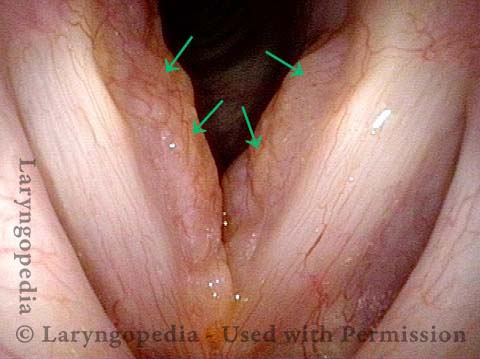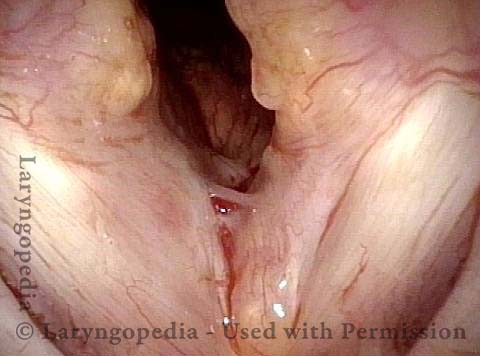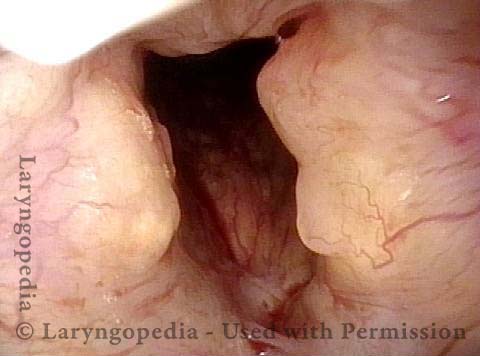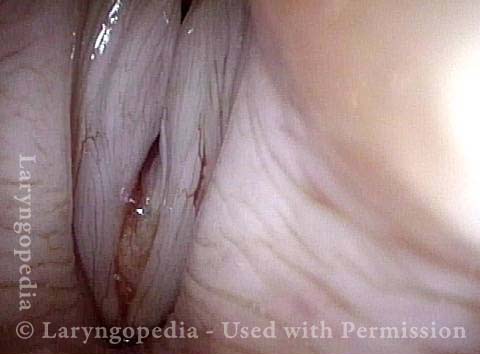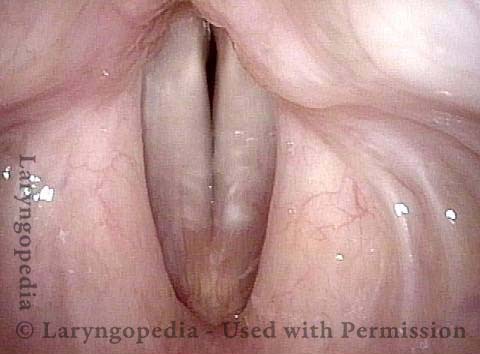A waxy, translucent protein substance deposited into tissue in response either to unknown local factors, or as a manifestation of systemic disease, such as multiple myeloma. Treatment is generally directed at improving function, for example via local laser excision.
See also: Amyloidosis
Amyloidosis of the Larynx as Seen Over Time, with Treatment
Primary laryngeal amyloidosis (1 of 7)
An example of primary laryngeal amyloidosis of the larynx. In this case, the yellowish, “candle-wax” proteinaceous material is being deposited just below the margin of the vocal cords (arrows).
Primary laryngeal amyloidosis (1 of 7)
An example of primary laryngeal amyloidosis of the larynx. In this case, the yellowish, “candle-wax” proteinaceous material is being deposited just below the margin of the vocal cords (arrows).
Bulky swelling (2 of 7)
When this person produces voice, the bulky swelling just below the margin of the vocal cords creates turbulence, incomplete match, and a rough voice quality. After laser debulking, the patient had a much improved voice for many years.
Bulky swelling (2 of 7)
When this person produces voice, the bulky swelling just below the margin of the vocal cords creates turbulence, incomplete match, and a rough voice quality. After laser debulking, the patient had a much improved voice for many years.
Amyloidosis (3 of 7)
Eight years later, the patient reappeared. She said voice had been good for many years but had been getting increasingly hoarse for the prior couple of years. Here you see major re-deposition of amyloid material.
Amyloidosis (3 of 7)
Eight years later, the patient reappeared. She said voice had been good for many years but had been getting increasingly hoarse for the prior couple of years. Here you see major re-deposition of amyloid material.
Amyloid deposits (4 of 7)
At very close range, the yellowish color typical of amyloid deposits is better seen.
Amyloid deposits (4 of 7)
At very close range, the yellowish color typical of amyloid deposits is better seen.
Vocal cords cannot close completely (5 of 7)
During voice production under strobe light, the amyloid deposit under the left vocal cord prevents closure.
Vocal cords cannot close completely (5 of 7)
During voice production under strobe light, the amyloid deposit under the left vocal cord prevents closure.
Amyloids Remain (6 of 7)
A year after laser debulking, the patient continued to have a very good voice, and only reappeared due to an unrelated question. As expected, smally amyloid deposits remain.
Amyloids Remain (6 of 7)
A year after laser debulking, the patient continued to have a very good voice, and only reappeared due to an unrelated question. As expected, smally amyloid deposits remain.
Voice remains clear (7 of 7)
When she produces voice, match and vibratory ability are very good, explaining her normal voice. It remans to be seen if amyloid will gradually reaccumulate over the next many years and need another debulking.
Voice remains clear (7 of 7)
When she produces voice, match and vibratory ability are very good, explaining her normal voice. It remans to be seen if amyloid will gradually reaccumulate over the next many years and need another debulking.
